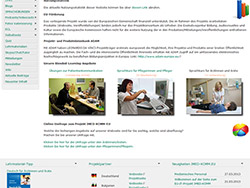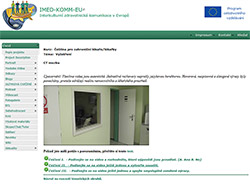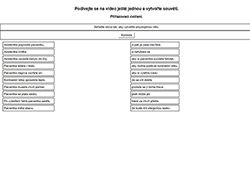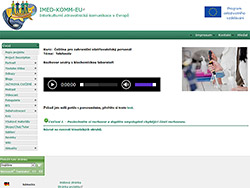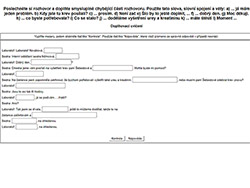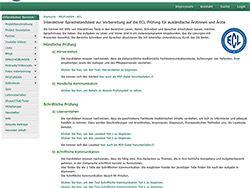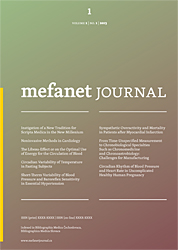
MEFANET Journal 2014; 2(2): 64-70
ORIGINAL ARTICLE
Possibilities of utilizing blended-learning in the area of language education of medical staff
Radka Šulistová*, Vlastimila Ptáčníková
Faculty of Health and Social Studies, University of South Bohemia in České Budějovice, Czech Republic
* Corresponding author: radka.sulistova@centrum.cz
Abstract
Article history:
Received 26 September 2014
Revised 16 November 2014
Accepted 22 November 2014
Available online 30 November 2014
Peer review:
Štefánia Andraščíková, Gerhard Wazel
Download PDF
This contribution deals with the presentation of teaching materials created within the IMED-KOMM-EU "Intercultural medical communication inEurope" internet project, having taken place under the leadership of the Institute for Intercultural Communication inGermany(Ansbach,Berlin,Jena,Erfurt). Project target was creating, testing, valorisation and permanent extending of the mentioned teaching materials, testing and certification technologies (ECL) for intercultural professional communication of foreign physicians and other medical staff. The target groups involving the already practising professionals, as well as students, should be able to utilize the existing possibilities of communication withinEuropeand to perform their professional activity or studies in the languages, in which the materials are elaborated. As a result, five complete courses of blended-learning were created, which are generally easily accessible at mutually connected web sites in Czech, Slovak, German, Bulgarian and Hungarian. Their core are modules orientated on practice with complex exercises online and offline focused on the medical communication, including the manuals for teachers.
Keywords
Blended-learning; language education; intercultural professional communication; communication competence; European certification
Introduction
A successful communication in the health system assumes that every medical employee should dispose of professional level of language competences representing the base for the effective communication with the clients as well as among medical staff at the workplace. The experience from practice show that the communication skills at least in one foreign language increase the value of the expert with such skills at the labour market in the whole EU. For this reason, IMED-KOMM-EU "Intercultural medical communication in Europe" [1] project was created the target of which was to support the sustainable professionally orientated foreign language teaching for the purpose of acquiring the job in health system in various EU countries. The project combines the traditional form of education for the purpose of acquiring a particular qualification with life-long learning of already professionally active experts. Its concept continues preceding projects of this type, e.g. MIG-KOMM-EU “Multilanguage intercultural business communication for Europe“, terminated in 2011. In this case, materials are determined for teaching professional language and professional communication to physicians and nursing staff.
The project is, among others, based on the fact that the language variety supported by EU brings, together with the necessity of additional language education also the necessity of intercultural education and for this reason also these aspects were included into the exercises focused on the development of the communication skills. Project originators are aware from the very beginning that modern technologies facilitate the language teaching doubtlessly and make it attractive to a certain extent. However, it would be erroneous to think that the technical support of education is a cure-all. Penetration of media into our life and mobility alone does not enable to recognize the national stereotypes and does not correct the problems in communication caused by missing knowledge of intercultural differences. The finding that managing intercultural competences falls behind other knowledge and skills [2] applies practically to all the areas of human activity.
We can designate the current time as information or media time; the reality is intermediated to us through mass media, among which television and internet have a privileged position [3]. Through internet, almost everything is achievable, including educational possibilities. Information and communication technologies penetrated into all the areas of life, including educational process; they were implemented there among others in the form of e-learning, the meaning of which for school education was highlighted in several EU documents, e.g. eEurope 2002 or eEurope 2005 [4]. Besides indisputable advantages, this form of education has minimally one negative feature: it is, in principle an impersonal form of communication not being able to replace a direct contact between the pedagogue and pupil/student.
Reasons for choosing blended-learning
The introduction of new technologies into education was initially welcomed with enthusiasm, e.g. in the USA, e-learning, also called tele-learning, has long tradition in connection with the distance learning. In this context it should be noted that reasons for its introduction were mainly economic, because the transmission of information via the intranet was much cheaper option, which brought the same results as conventional forms of training. Therefore, new information technologies started to be used in further education of employees in large firms, banks and insurance companies, obviously with great success [5]. As time moved on, it became apparent that this form of courses is not applicable in all forms of education. It is successful in the case of transmission of accurate data, but there are areas where immediate communication between the teacher and the student, or among students themselves, a substantial part of the curriculum. Such an area is undoubtedly the language education.
During rotation of different teaching methods in the classroom - not only foreign languages - it turned out that mere self-study by means of information technologies has not brought the expected results [6] and that the integration of the phases with direct contact between the teacher and the student is irreplaceable. Information technologies are indeed very beneficial in the educational process. It can be said that they make learning more attractive, but their function is rather supportive [7].
For this reason, the starting point for creation of the multi-language educational IMED-KOMM-EU project became the possibility of implementation of “blended-learning“, i.e. combination of E-learning with traditional contact teaching which may be defined as learning focused on optimum achieving of learning targets by means of suitable technologies [8].
The creators of the above project proceed from the fact that e-course must be composed, as Barešová shows for example, of the content of education, distribution of e-courses and the overall organization of the course in direct cooperation with the participants of the course [9]. The success rate is not guaranteed by the mere creation of educational materials focused on the specific needs of the target group, but it is also important to verify them in practice. For this reason, the materials have been thoroughly tested and evaluated and also the information about their existence was spread, e.g. in the form of newsletters or contributions at events focusing on foreign language teaching. Such events include meetings of the Association of Teachers of Czech as a Foreign Language [10].
It can be said that the project IMED-KOMM-EU is not just teaching material, but also provides comprehensive information on the issue, including links Podcasts, Videocasts or Wiki, so its results are presented in the form of web gateways with exercises designed as a blended-learning course.
The project priority is organisation of language courses focused on the training of medical communication including the professional part as well as exercises focused on the knowledge necessary for the successful communication between the clients (patients) and medical staff or medical staff mutually. During the implementation of mentioned exercises, it was assumed that the unsuitable communication by the medical staff arouses unpleasant experiences in the client which are difficult to remove and remedy. It may be said, identically as teachers are the decisive element for the positive relationship of the pupil to teaching, medical staff is influencing factor of the total attitude of the client to the treatment [4].
Table 1. Characteristics of medical facility
|
Medical facility |
|
|
State medical facility |
96 % |
|
Non-state medical facility |
4 % |
Table 2. Professional focus and specialization of respondents
|
Professional focus |
|
|
General nurse |
70 % |
|
Midwife |
26 % |
|
Physiotherapist |
4 % |
|
Specialization |
|
|
Internal medicine |
37% |
|
Surgery |
29 % |
|
Palliative care |
4 % |
|
Gynaecology/obstetrics |
26 % |
|
Physiotherapy |
4 % |
Table 3. Level of language skills of respondents
|
Level of initial language skills of respondents |
|
|
B1 |
70 % |
|
B2 |
30 % |
Table 4. Results of evaluation of teaching material
|
Demands of course exercises |
|
|
Appropriate |
70% |
|
Difficult |
30% |
|
Instructions to exercises |
|
|
Understandable |
74% |
|
Less understandable |
26% |
|
Topics, demands of texts |
|
|
Corresponding |
100% |
|
Non-corresponding |
0% |
|
Importance of inter-culturally focused exercises |
|
|
1 |
59% |
|
2 |
22% |
|
3 |
19% |
Project targets
E-learning as individualized form of teaching offers many various combinations of methods which are important to think about. First of all the aim of teaching shall be taken into consideration. The use of many methods attractive at first sight does not guarantee the success as by their not-well thought combination, the chaos and non-effective or even bad transfer of knowledge or skills at which the teaching was aimed may be caused. “Blended- learning“ is combination of e-learning with traditional contact teaching; it is a method trying to replace some disadvantages of e-learning. One of the variants of “blended-learning“ is teaching taking place in the real time and space in which all the participants accept information simultaneously and react on each other in the virtual class where they can meet in the same time by means of information and communication technologies and communicate although they are in different places. Another way may be the combination of contact teaching and e-learning course with which the participants work individually, i.e. in various time they can select the way of accepting information without possibility to react on each other mutually. Contact teaching in the seminar or workshop, implemented from time to time follows after the individual study.
Initital exploration ot the project
The project commenced in October 2012 within innovative LEONARDO DA VINCI transfer program supported by EU, under the leadership of the Institute for Intercultural Communication, registered association (IIK Institut für Interkulturelle Kommunikation e. V., Ansbach, Berlin, Jena, Erfurt), in co-operation with other project partners, Medical University of Varna, Institute of Language and Intercultural Communication s.r.o. in Nitra, Faculty of Health and Social Studies of the University of South Bohemia in České Budějovice and Language Center of Pécs Univerzity.
Creation of teaching materials was preceded by extensive search and questionnaire investigation having enabled to determine the following project targets: creation and systematization, modernization, testing, optimization, valorisation and permanent extension of modern, innovative teaching materials and testing and certification techniques (ECL) for intercultural professional communication of foreign physicians and other medical staff in the countries of consortium as well as in other member states of EU. The target groups should be able to utilize the existing possibilities of communication in Europe and to perform their professional activities in member states of EU.
The first search concerned first of all establishing the demands on professional activities and communicative competences of medical staff in individual countries of consortium; the source of information were first of all the provisions concerning the respective qualification criteria for executing medical professions in individual countries of consortium and associated demands on language competences, which the foreign staff shall acquire before taking up the job in the respective country. The source of information became also the requirements of partners from practice and institutions educating future medical staff including the education of foreigners. In the second stage of investigation which took place in the tested groups having worked with courses already, the particular first experience of students with teaching materials was found out. The results from this phase are presented in Table 4. For a better idea, we state the results of a part of the questionnaire investigation implemented at the Faculty of Health and Social Studies of University of University of South Bohemia in České Budějovice in which 27 respondents working in nursing professions participated. Table 1 presents characteristics of the respondents according to a medical facility. Professional focus and specialization of respondents specifies Table 2. Table 3 contains the input language skills of respondents.
Moreover the respondents considered for interesting the following methods included into the course: self-evaluation, quiz, glossary and exercises focused on the development of communicative competences.
Based on the stated investigation, analysis of needs and experience from pedagogical practice, teaching materials were created which were subsequently systematized and updated based on unified conception as well as integrated into the new innovative teaching environment customized to target groups of project. In the final form, they should be used to the identical extent for the education of adults as well as for professional preparation at schools preparing the future medical professionals.
Project results
As follows from project targets, the main result is the modern teaching environment, i.e. five complete courses of “blended-learning“, focused on target groups and specifics of particular country, available at web portals for intercultural medical communication in German, Bulgarian, Slovak, Czech and Hungarian in the following structure:
- Language courses German, Bulgarian, Slovak, Czech and Hungarian for foreign physicians
- Language courses German, Bulgarian and Czech for foreign medical staff
- Language courses Communication with patient in German, Bulgarian and Czech
- Language courses German for physicians and medicine students.
Besides the exercises for online and offline stages, the project brought other results:
- Research associated with the main items of project (first of all with products/materials) in partner countries and their publishing
- Creation of unified methodical-didactic concept for 5 courses, i.e. determination of topics for programmed exercises and exercises for teaching with attendance.
- Creation of manual for pedagogues with instruction how to work with courses of „blended-learning“
- Creation of 5 mutually interconnected interactive web-sites with the “blended-learning“ course, manuals, programmed exercises and exercises for teaching with attendance, videos, audio-recordings, instructions, glossaries, tests for ECL examinations, pod-casts/video-casts, wiki, references, quiz, online questionnaires, forms, statistics, blogs and photo-galleries to the medical communication
- New testing material to ECL tests in 5 languages of partners: curricula, model tests, standard tests
- Assurance of valorisation/sustainability through advisory board, workshops and conferences.
Figure 1. The homepage of the project website
Figure 2. A screenshot from the Czech language course
Figure 3. A screenshot from the Czech language course
Figure 4. A screenshot from the Czech language course
Figure 5. A screenshot from the Czech language course
Figure 6. An example of a test included in a course
Structure of teaching platform
“Blended-learning“ includes interactive website with several language courses representing the central part of the teaching and having a modular structure:
- Federal Republic of Germany: http://www.imed-komm.eu/
- Bulgaria: http://dp.mu-varna.bg/?q=zaglavna
- Slovak Republic: http://imed-komm.eku.sk/
- Czech Republic: http://imed-komm.jcu.cz/
- Hungary: http://inyt.pte.hu/imedkomm/
The structure of website unified for all the countries consists of several parts. A more detailed structure is located at initial website of projects partners.
Characteristics and contents of language course
Language courses in narrower sense of word (programmed exercises for self-study and not-programmed exercises for contact stage of teaching) are located at external website and they are highlighted there (e.g. through large photographs), as visible e.g. at the website displayed in Figure 1.
In modules of these courses, texts and situations may be found which could be relevant for the area of activity of course participant. At the beginning, there are printed or spoken texts and videos the participant has to go through obligatorily and the tasks follow concerning the fundamentals of the respective branch and the grammar parts making problems during the study of foreign language by foreigners. Quiz as part of self-study shall inform the course participants how good is their professional and language knowledge in the respective branch. They can decide according to them, which units or which topics they would like to study in the scope of modular arrangement.
The target of courses is the development of all the four language skills, i.e. reading with comprehension, listening with comprehension, written and oral communication, although we are aware that determination of their main items is very complicated as the requirements depend on many external as well as internal factors, first of all on the respective area of activity.
The main parts of these four language skills are developed differently, depending on specific characteristics of situation of self-study or language teaching, being implemented just now, e.g. on the used technical means. In programmed exercises, the tasks and exercises for reading and listening with comprehension or guided writing prevail; in the contact stage of the lessons, first of all the oral and free written communication is developed or supported. The selection of vocabulary for the written and oral communication is determined considerably by the choice of texts, audio-recordings and video-recordings. The selection of main grammar issues is influenced very strongly by the kind of texts; these are texts usual in the medical communication.
To have a better idea, we state the examples of several exercises from the Czech course showing the possibilities of preparing the teaching video and audio-recording for the self-study (Figures 2-5).
As already mentioned, the course contains the exercises for self-study as well as for contact stage of teaching. It is supposed that the students will be introduced into the topic in the stage with personal attendance, acquire the vocabulary, train the basic communication and subsequently exercise everything in the form of tests published at web site of the project individually. During the following contact teaching, the teachers will consult everything with students and train the parts of curriculum causing problems. In the annex we state for better idea the example of lecture for contact stage of teaching coming from the Czech course for nursing staff.
It is possible to work with course as one whole or to select only individual parts based on professional focus or sphere of interest. In case of course lead by a pedagogue the teacher will decide which parts will be selected for the contact stage of teaching and which for self-study. For this reason, the part with attendance is elaborated in PDF, so that the teacher could select the parties corresponding to topical needs of teaching in the group.
The initial level of course students supposes the knowledge minimally on the level B1 of the Common European framework of reference for languages and the structure of exercises focused on grammar is influenced hereby. The contents of exercises is based on the initial text which enables to deepen also the vocabulary together with grammar phenomena.
A part of study materials are also the exercises focused on the development of intercultural competences located in the special module “Exercises for training of communication with patient“. The students should acquire here the key information for successful communication with clients including the clients from a different cultural environment.
Including ECL tests into project
The elaboration of standardized systems of tests and examinations has turned to be especially necessary. In the project scope, a special extensive complex of ECL tests and examinations was planned. The reason for this part of the project is that the medical staff needs professional language competence for its successful practical activity in clinic, hospital or for its own medical offices– physician at least on the level C1, medical staff at least on the level B2. For this reason, consortium decided to suggest and to offer with prospects for the future especially to these clients another type of course “blended-learning“, focused not only on the teaching of oral communication but on all four key language competences, and subsequently, after this course, the intended standardized over-regional ECL examination in professional language. The respective model tests may be found at websites of project (Figure 6).
Conclusion
There are currently (in comparison with the huge boom in information technology in general) relatively few studies dealing with the introduction of e-learning, respectively blended-learning in language teaching. For example, in Aula magazine, which deals with the issue of tertiary education, between the years 2010 - 2013 there were only 8 posts relating to information technology applied to universities, i.e. the use of e-learning in university education. However, neither of these studies dealt with the education of language. Already in 2003 Karel Květoň pointed out the low rate of e-learning in tertiary education [11]. It seems that over the years not much has changed, or the educators who use e-learning in teaching do not share their experience. Based on the above findings, it can be assumed that the project IMED-KOMM-EU, focusing on foreign language communication in the healthcare environment is rather unique. The lack of educational blended-learning materials aimed for training communication in medical environment was indeed a reason why the project was financially supported by the EU. For this reason, unfortunately, the products published on its web portals and experience acquired through evaluation of created courses cannot be compared with other studies dealing with teaching medical communication in foreign languages.
Courses of “blended-learning“ created within IMED-KOMM-EU project represent, as already mentioned, the form of teaching connecting the advantages of self-study on one hand with advantages of the direct contact between the lecturer/tutor and course participants on the other hand. The superior target of courses is the development and subsequent strengthening of key competences focused on the professionally orientated intercultural medical communication and European certification. Hereby, the project aims at contributing first of all to the life-long professional education in health system, the purpose of which is the success at the labour market, and also strengthening the European integration.
As the language courses are destined for a wide range of interested persons, i.e. physicians and other professional medical staff as well as student of medicine and non-physician branches, it is supposed that the trouble-free availability of created teaching materials will contribute to extension of foreign language communication of medical staff, very necessary for executing medical profession in the home environment as well as within EU.
Information and communication technology can be used in all forms of studies - full-time courses, part-time courses, as well as distance study [12, 258]. Created teaching materials can be effectively used in teaching a foreign language, both in the full-time and in the distance form of study at universities with medical specialization. The reason for their use is, besides possible adaption to the individual needs of students, a relatively low number of hours of language teaching, so it is useful to combine contact learning with self-study. The implementation of e-learning should make teaching certainly more efficient, which is facilitated by possible immediate feedback when solving programmed exercise.
The target of creators of the Czech project version for the next period is additional testing of German teaching materials in the lessons of professionally focused German at the Faculty of Health and Social Studies of the University of South Bohemia in České Budějovice and the parallel following to what extent the method of “blended-learning“ contributes to improving communicative competences of students, who can utilize them subsequently during their practice in medical facilities of German speaking countries. We believe that thanks to research in this area we could extend the literature on the use of e-learning in teaching foreign languages at Czech universities.
References
1. IMED-KOMM-EU: Intercultural Medical Communication in Europe. [On-line]. Available at WWW: http://www.imed-komm.eu/.
2. Wazel G. Multilingual Intercultural Business Communication for Europe – a topical multilateral Blended-Learning-Project. In: Hahn M., Wazel G (eds). Theory and Practice of German as a Foreign Language Teaching today. Peter Lang: Frankfurt am Main, 2011: 309–336 [in German].
3. Pavličíková H. Communication in Global Processes and Media Literacy. In: Physics and Ethics VI. Communication in Global Processes and Changes in Quality of Life. Constantine the Philosopher University in Nitra: Nitra, 2012: 105–112 [in Slovak].
4. Šulistová R. E-Learning Possibilities in the Development of Interactive Skills in Supporting Professions. Informatologia 2013; 46(3): 247-255 [in German].
5. Prowaznik B. The Long Way to Internet. [On-line]. Available at: http://www.iik.de/sites/default/files//publikationen/prowaznik.pdf [in German].
6. Kolibač R. E-Learning – the Modern Education Form. University of Ostrava: Ostrava 2003 [in Czech].
7. Nicholson P. A History of E-Learning: Echoes of the Pioneers. In: Fernández-Manjón B, Sánchez-Pérez JM, Gómez-Pulido JA, Vega-Rodríguez MA, Bravo-Rodríguez J (eds). Computers and Education. E-learning, From Theory to Practice. Springer: Dordrecht, 2007: 1-11.
8. Zounek J. E-Learning – One of Learning Forms in the Modern Society. Masaryk University: Brno 2009 [in Czech].
9. Barešová A. E-Learning in Adult Education.VOX: Prague 2003 [in Czech].
10. Ptáčníková V. Czech for Foreigners – Intercultural Medical Communication. In: Vacula R (ed). Anthology of Association of Czech as a Foreign Language Teaching (AUČCJ) 2013. Prague 2013: 295-305 [in Czech].
11. Květoň K. Foundations of E-Learning 2003. University of Ostrava: Ostrava 2004 [in Czech].
Please cite as:
Šulistová R. Possibilities of utilizing blended-learning in the area of language education of medical staff. MEFANET Journal 2014; 2(2): 64-70. Available at WWW: http://mj.mefanet.cz/mj-04140926.
This is an open-access article distributed under the terms of the Creative Commons Attribution-NonCommercial-ShareAlike 3.0 License (http://creativecommons.org/licenses/by-nc-sa/3.0/), which permits unrestricted use, distribution, and reproduction in any medium, provided the original work, first published in the MEFANET Journal, is properly cited. The complete bibliographic information, a link to the original publication on http://www.mj.mefanet.cz/, as well as this copyright and license information must be included.
